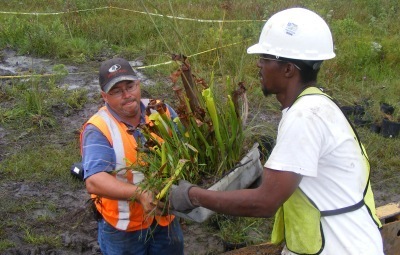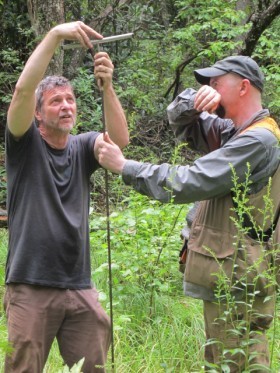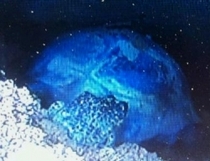Statesboro
Answering an SOS for pitcherplants
By Lisa Kruse
When I first walked the Statesboro bog, it was home to hundreds of yellow pitcherplants. Their abundant pitchers caught the hard summer sun, transforming it into resplendent green light.

Martha Joiner, the site’s “Botanical Guardian,” recalled prior visits. “We’ve seen white-fringed orchids here, plenty of grass-pink orchids, too, and we used to see purple honeycomb-heads,” she said.
However, looming over all were construction vehicles that had graded the surrounding slopes for a housing complex. Martha, fellow Botanical Guardian Alicia Garcia and I were visiting the site to determine if we could rescue any portion of the bog.
We were too late to influence the development. Yet we had hope.
Many had answered Joiner’s call for help to move and find homes for the plants. Construction planners for the site had also offered to help.
The challenge: We had only six weeks to plan and implement a scientifically sound rescue of hundreds of pitcherplants and associated flora. ...
Read DNR botanist Lisa Kruse’s full blog post on the Statesboro bog rescue!
You'll find more pictures on Flickr, and a profile of Martha Joiner, TERN's 2010 Volunteer of the Year, here.
|

Pitcherplant backgrounder
The yellow pitcherplant, also called yellow trumpet pitcherplant and yellow flytrap, is probably the most common of Georgia’s pitcherplants, historically occurring in at least 42 counties.
The species is state-protected and was originally added to the list because of the threat of poaching and commercial exploitation. However, much of the plant’s habitat has since been destroyed and many of the older populations are gone.
History at the core
Researchers explore 'archives'
in Appalachian bog sediments
The sediments that accumulate in bogs and wetlands in the southeastern U.S. serve as important archives of environmental history. Collecting and analyzing sediment cores from these sites offers a way to chart changes in local and regional environments over time. For example, pollen grains in sediments provide evidence of vegetation at different times in history, and charcoal particles attest to past fires.

Drs. Sally Horn and Henri Grissino-Mayer, along with doctoral student Mathew Boehm, all from the university’s Geography Department, are exploring bogs in North Carolina and Georgia to find suitable sites for studies of long-term environmental history. Their recent trip to Georgia focused on mountain bog complexes at Hale Ridge and Keener Creek.
The researchers found the Sedge Bog within the Keener Creek bog complex particularly promising.
This small bog covered in a thick carpet of graminoids, most of them sedges, “Looks to be a unique site with deeper sediments and less human disturbance than we've seen at other bogs in the Appalachian region,” Horn said.
That combination of deep sediments and limited disturbance could make Sedge Bog “an important site for research using analyses of sediment cores to reconstruct past vegetation, fire and climate.”
Future explorations are planned for mountain bogs in Union County.
Why bogs?
Like most other wetlands, bogs trap sediments that run off from surrounding areas.
Over time, uplands erode and their sediments – including organic matter from organisms, pollen, charcoal from fires and other sources – move into and along the watershed. If the local geologic, topographic and hydrologic conditions are right, the sediments are trapped in the bog, instead of eventually flowing to the ocean. Deeper sediments reflect older depositional events.
Once trapped, under certain circumstances the organic material is preserved or fossilized. Heavy, wet sediments are compressed, compacted and quickly become anoxic, or severely deficient in oxygen. The anoxic conditions, coupled with the cool, acidic nature of mountain bogs, preserve the organic component of the sediments from the normal processes of decomposition and oxidation.
Sedge Bog snapshot
-
One of several bogs in the Keener Creek bog complex on the Chattahoochee National Forest.
-
About a 10th of an acre in size; covered with graminoids.
-
Restoration efforts have removed most woody species.
-
Bog is accented with outplanted swamp pink, now mature enough to bloom and reproduce, and a robust, naturally occurring population of kidney-leaved grass-of-Parnassus.
-
Organic sediments, above the rocky substrate, are 10-plus feet deep and appear well preserved.
|
Noteworthy
Gopher tortoises are going strong at Moody Forest Natural Area, with more juveniles and sub-adults than normal – about a quarter of the tortoises found. The healthy recruitment, documented in surveys by the Nongame Conservation Section and The Nature Conservancy, likely points to growing numbers for Georgia’s state reptile at the natural area near Baxley.
 The first evidence of gopher frogs surviving their release at Williams Bluff is in. This eerie-looking image ( left) recorded Sept. 19 in a gopher tortoise burrow at the Early County preserve shows one of more than 4,300 gopher frogs released as tadpoles or metamorphs to re-establish the imperiled species at the site. ( You'll find project details in Nongame Conservation Section’s annual report.)
-
Editor's note: In the photograph, the frog is in front of a gopher tortoise (you can see the tortoise's shell)!
Amos Tuck’s odyssey – a recent three-week, 200-mile float trip in the Coosa River basin – is documented in words, photographs and video at the Coosa River Basin Initiative’s Musselhead Blog. Tuck, a former Nongame Conservation Section intern, is program coordinator of the Coosa conservation organization.
Put your inner scientist to work through SciStarter, a website that helps connect citizen-science projects with science-minded citizens. Plug into projects varying from worldwide views on biodiversity to sighting banded American oystercatchers and reporting invasive brown marmorated stink bugs.
Upcoming:
- Oct. 4-6: Gopher Tortoise Council annual meeting, Kirbo Center at Bainbridge College, Bainbridge.
- October-November: Bird-banding opportunities for volunteers organized by Georgia Important Bird Areas Coordinator Charlie Muise include: Joe Kurz WMA – 7 a.m. Oct. 19, 7:10 a.m. Oct. 28, 7:15 a.m. Nov. 2 and (tentatively) 6:30 a.m. Nov. 16; Panola Mountain State Park – 6:45 a.m. Oct. 20, 6:50 a.m. Oct. 27, 6 a.m. Nov. 10 and 6:15 a.m. Nov. 25. Details: Email Charlie Muise.
- Oct. 18-19: Georgia Plant Conservation Alliance fall meeting, F.D. Roosevelt State Park, Pine Mountain.
- Oct. 20: Open house 10 a.m.-2 p.m. at Joseph W. Jones Ecological Research Center, Newton.
-
Nov. 8: Georgia Exotic Pest Plant Council annual meeting and conference, Stuckey Conference Center, UGA Griffin Campus.
- Nov. 10: Start of 2012-2013 Project FeederWatch.
|
Headlines
Parting shots
 |
|
It was no day – or season – at the beach for beach-nesting birds in Georgia this summer. High-tide events, from the super Moon in May to tropical storms Beryl and Debby, flooded scores of nests, including 538 brown pelican nests washed over on Little Egg Island Bar, according to Nongame Conservation Section botanist Tim Keyes. Predators such as raccoons and fish crows also took a toll. There were highlights, however. One that Keyes noted is St. Catherines Island bar, inactive for several years but one of the largest seabird colonies of 2012 with 230 black skimmer nests, 65 gull-billed tern nests and 46 least terns. Also, a Georgia Ornithological Society grant provided electric fencing to help protect nests on Andrews and Little St. Simons island, adding to new fencing efforts that kept some raccoons, mink and coyotes at bay. Pictured top left are some of the thousands of royal terns that nested on the Brunswick dredge island. At bottom left, brown pelicans persevered in nesting on a relatively protected marsh island behind Cumberland Island.
|
.
Credits
** Masthead: royal tern colony. Tim Keyes/Ga. DNR
** Yellow pitcherplants. Lisa Kruse/Ga. DNR
** Jeremy Kicklighter, left, and Jimmie Lee III help remove pitcherplants from Statesboro bog. Tom Patrick/Ga. DNR
** Dr. Henri Grissino-Mayer, left, and doctoral student Matthew Boehm sample a Rabun County bog. Mincy Moffett/Ga. DNR
** Gopher frog in tortoise burrow at Williams Bluff. Vanessa C. Kinney Terrell
** Royal tern colony on the Brunswick dredge island. Tim Keyes/Ga. DNR
** Brown pelican nesting. Tim Keyes/Ga. DNR
Give wildlife a chance!
The Nongame Conservation Section of Georgia DNR receives no state funds to conserve nongame wildlife, native plants and natural habitats. Instead, we depend on contributions, grants and fundraisers, such as the eagle and hummingbird license plates.

How can you help?
Learn more about the Nongame Conservation Section in our annual report.
|
|